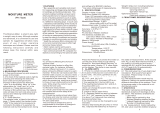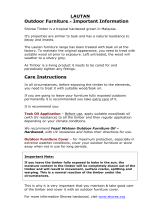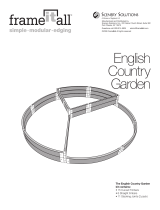TFA Wood Moisture Meter HUMIDCHECK PRO Owner's manual
- Category
- Measuring & layout tools
- Type
- Owner's manual
This manual is also suitable for
Page is loading ...
Page is loading ...
Page is loading ...
Page is loading ...
Page is loading ...
Page is loading ...
Page is loading ...

- 8 -
Gummi, Saligna B
Gummi, Southern B
Gummi, Spotted A
Gurjun A
Hemlock, Western C
Hiba J
Hickory F
Hyedunani B
Iroko F
Ironbank B
Jarrah C
Jelutong C
Karpur A
Karri A
Kauri, New Zealand E
Kauri, Queensland J
Keruing F
Kiefer, American long leaf C
Kiefer, American pitch C
Kiefer, Bunya B
Kiefer, Caribbean Pitch C
Kiefer, Corsican C
Kiefer, Hoop C
Kiefer, Huon B
Kiefer, Japanese Black B
Kiefer, Kauri E
Kiefer, Lodgepole A
Kiefer, Maritime B
Kiefer, New Zealand White B
Kiefer, Nicaraguan Pitch C
Kiefer, Parana B
Kiefer, Ponderosa C
Kiefer, Radiata C
Kiefer, Red B
Kiefer, Scots A
Kiefer, Sugar C
Kiefer, Yellow A
Kuroka A
Lärche(europ. C
Lärche(jap.) C
Lärche(Western) F
Lime E
Loliondo C
Mahagoni(afrik.) J
Mahagoni(ind.) B
Makore B
Mansoia B
Matai E
Meranti, Red (dark/light) B
Meranti, White B
Merbau B
Missanda C
Muhuhi J
Muninga G
Musine J
Musizi J
Myrtle, Tasmanian A
Naingon C
Obeche G
Odoko E
Okwen B
Olive, E African B
Olivillo G
Opepe H
Padang A
Padauk, African F
Panga Panga A
Persimmon G
Pillarwood F
Poplar, Black A
Pterygota, African A
Pyinkado E
Queensland Kauri J
Queensland Walnut C
Ramin G
Rotholz, Baltic (European) A
Rotholz, Californian B
Rosenholz, Indian A
Rubberwood H
Santa Maria H
Sapele C
Sen A
Seraya, Red C
Silky Oak, African C
Silky Oak, Australian C
Stringybark, Messmate C
Stringybark, Yellow C
Sterculia, Brown A

- 9 -
Sycamore F
Tanne, Douglas B
Tanne, Grand A
Tanne, Noble J
Tallowwood A
Teak F
Totara E
Turpentine C
Ulme, apanese Grey Bark B
Ulme, English E
Ulme, Rock E
Ulme, weiß E
Utile J
Walnuss, African J
Walnuss, American A
Walnuss, European C
Walnuss, New Guinea B
Walnuss, Queensland C
Wawa G
Wandoo J
Whitewood C
Yew C
Zeder, Japanese B
Zeder, West Indian J
Zeder, Western Red C
Zelkova serrata B
Zwergbirke alba J
Zwergbirke alleghaniensis J
Zwergbirke pendula J
Zwergbirke spp J
Zypresse, E African A
Zypresse, Japanese (8-18%mc) J
Zypresse, Japanese (18-28%mc) C
Botanische Namen der Hölzer
Abies alba B
Abies grandis A
Abies procera J
Acanthopanex ricinifolius A
Acer macrophyllum A
Acer pseudoplatanus F
Acer saccharum A
Aetoxicon punctatum G
Aformosia elata G
Afaelia spp E
Agathis australis E
Agathis palmerstoni J
Agathis robusta J
Amblygonocarpus andgensis A
Amblygonocarpus obtusungulis A
Araucaria angustifolia B
Araucaria bidwilli B
Araucaria cunninghamii C
Berlinia grandiflora B
Berlinia spp B
Bosquiera phoberos A
Brachylaena hutchinsii J
Brachylaena spp B
Calophyllum brasiliense H
Canarium schweinfurthii B
Cardwellia sublimes C
Carya glabra F
Cassipourea elliotii F
Cassipourea melanosana F
Castanea sutiva C
Cedrea odorata J
Ceratopetalum apetala G
Chamaecyparis spp (8-18%mc) J
Chamaecyparis spp (18-28%mc) C
Chlorophora excelsa F
Cordial alliodora F
Corton megalocarpus J
Cryptomelia japonica B
Cupressus spp A
Dacryium franklinii B
Dalbergia latifolia A
Diospyros virginiana G
Dipterocarpus (Keruing) F
Dipterocarpus zeylanicus A
Distemonanthus benthamianus C
Dracontomelium mangiferum B
Dryobanalops spp A
Dyera costulata C
Entandrophragma angolense H
Entandrophragma cylindricum C
Entandrophragma utile J

- 10 -
Endiandra palmerstoni C
Erythrophleum spp C
Eucalyptus acmenicides C
Eucalyptus crebra B
Eucalyptus diversicolor A
Eucalyptus globules B
Eucalyptus maculate A
Eucalyptus marginata C
Eucalyptus microcorys A
Eucalyptus obliqua C
Eucalyptus pilularis C
Eucalyptus saligna B
Eucalyptus wandoo J
Fagus sylvatica C
Flindersia brayleyana B
Fraxinus Americana B
Fraxinus excelsior A
Fraxinus japonicus A
Fraxinus mardshurica A
Gonystylus macrophyllum G
Gossweilodendron balsamiferum J
Gossypiospermum proerox A
Grevillea robusta C
Guarea cedrata H
Guarea thomsonii J
Guibortia ehie B
Hevea barsilensis H
Intsia bijuga B
Juglans nigra A
Juglans regia C
Khaya senegalensis E
Khaya ivorensis J
Larix deciduas C
Larix kaempferi C
Larix leptolepis C
Larix occidentalis F
Liquidamper styraciflua A
Lovoa klaineana J
Lovoa trichiloides J
Maesopsis eminii J
Mansonia altissima B
Millettia stuhimannii A
Mimusops heckelii B
Mitragyna ciliate E
Nauclea diderrichii H
Nesogordonia papaverifera C
Nothofagus cunninghamii A
Ochroma lagopus A
Ochroma pyramidalis A
Ocotea rodiaei C
Ocotea usambarensis C
Octomeles sumatrana E
Olea hochstetteri B
Olea welwitschii C
Palaquium spp A
Paulownia tomentosa J
Pericopsis elata G
Picea abies C
Picea jezoensis (8-18%mc) J
Picea jezoensis (18-28%mc) C
Picea sitchensis C
Picaenia excelsa C
Pinus caribaea C
Pinus contorta A
Pinus lampertiana C
Pinus nigra C
Pinus palustris C
Pinus pinaster B
Pinus ponderosa C
Pinus radiate C
Pinus spp B
Pinus strobus A
Pinus sylvestris A
Pinus thunbergii B
Pipadeniastrum africanum A
Piptadenia africana A
Podocarpus dacrydiodes B
Podocarpus spicatus C
Podocarpus totara E
Populus spp A
Pruns avium J
Pseudotsuga menzesii B
Pterocarpus angolensis G
Pterocarpus indicus G
Pterocarpus soyauxii F
Pterygota bequaertii A
Quercus cerris E
Quercus delegatensis C
Page is loading ...

- 12 -
Timber moisture meters
OWNER’S
MANUAL
Content
Title Page
Figure…………………………………...3
USER INSTRUCTION………………..4
1. Measuring Instruction…………………………….4
2. Using this instrument without
the Temperature Probe……………………………5
3. Automatically Temperature
Corrected (ATC)………………………………….5
4. Set-up Automatically Switch-off Time……...........6
5. Calibration Check…………………………………7
6. Care and Maintenance…………………………….7
Calibration Tables for Wood………….8
Common names of timbers as BS888&589:1973…….8
Botanical Names of Timbers………………………...14
Notes………………………………………………...20

- 13 -
T
Temperature probe
Needle electrodes
Heavy duty
moisture probe

- 14 -
USER INSTRUCTION
This instrument is a conductivity moisture meter specifically designed for the
timber industry. The instrument has eight calibration scales, enabling the user to take
accurate moisture measurements in 150 wood species. Moisture measurements can be
taken using the integral pin electrodes, or using the heavy duty moisture probe. When
used with the temperature probe, the moisture measurements are automatically
corrected with respect to temperature. This instrument is switched on by pressing
“ ” momentarily and switched off by pressing “ ” and holding for 3 seconds or
more. The instrument will switch off automatically after 5 minutes, the default
automatically switch off time can be setting range 1 to 9 minutes (see section 4).
1. Measuring Instruction
Remove the cap to expose the needle electrodes OR Connect the heavy duty
moisture probe socket on the right hand side of this instrument and switch-on by
pressing “ ”. Select the appropriate wood calibration scale (A, B, C, E, F, G, H or
J) by referring to the enclosed wood calibration table and pressing “ ”. Push the
needle pins or the heavy duty moisture probe pins into the wood and observe the
reading.
2. Using this instrument without the Temperature Probe
The instrument is calibrated for wood at 20°C (68°F). In general, timber that is
hotter than 20°C will give higher readings and timber colder than 20°C will give
lower readings. An approximate manual correction of 0.5% moisture content per 5°C
may be subtracted from timber that is above 20°C. For timber that is below 20°C, a
manual correction of 0.5% moisture content per 5°C may be added to the measured
value.

- 15 -
3. Automatically Temperature Corrected (ATC)
Switch the instrument on and select the appropriate wood calibration scale as
detailed in sections 1. Using a hammer and nail of nominal 3 mm diameter, make a
hole in the wood to be tested. Remove the nail and push the Temperature Probe into
the hole until the tip is at the required depth. Connect the Temperature Probe into the
instrument via the “Temp” socket. Then using this instrument to measure timber
can obtain the automatically temperature corrected (ATC) moisture value. If you need
to reading current temperature of timber press “T” button, then LCD will display the
temperature. Press “T” button the LCD will display the other °C or °F temperature.
Pressing “ ” button the LCD display moisture value again. (Temperature Range: -
35°C ~ 80°C).
4. Set-up Automatically Switch-off Time
Combinatorial using “ ” + “ ” button can change the default
automatically switch-off time. Depress the “ ” button don’t release and press the
“ ” button will change automatically switch-off time (disable automatically switch-
off or set from 1 to 9 minutes) by change the code as detailed in the following table.
Code Description
0 Disables automatic switch-off
1 Selects automatic switch-off at 1 minute
2 Selects automatic switch-off at 2 minutes
3 Selects automatic switch-off at 3 minutes
…… ……And so on to……
9 Selects automatic switch-off at 9 minutes

- 16 -
5. Calibration Check
There are two checked calibration in the cap of the instrument. Use the needle
touch the two poles of calibration. When checking the calibration, the A scale should
be selected and the temperature probe must be disconnected. Correctly calibrated the
instrument will register %H2O values in the range 17.7 to 18.3(at the “T” calibration)
and in the range 25.5 to 26.5 (at “B” calibration). (If the tolerance overs+/-1 the
instrument can’t accurately measure the moisture of timber, then open the back
cover, adjust the rheostat to make it tolerance meet the range.)
6. Care and Maintenance
When the instrument is not in use, keep it in its pouch together with its
accessories. Store the kit in a stable, dust-free environment out of direct sunlight.
Remove the batteries from the instrument if it is to be stored for periods of more than
one month, or when the low battery power symbol appears on the display. Check the
condition of accessories used with the instrument on a regular basis and replace them
if they become worn or damaged.

- 17 -
Calibration Tables for Wood
Timber Species Group Table
Common names of timbers as
BS888&589:1973
Abura E
Afara A
Aformosa G
Afzelia E
Agba J
Amboyna G
Ash, American B
Ash, European A
Ash, Japanese A
Ayan C
Baguacu, Brazilian F
Balsa A
Banga Wanga A
Basswood G
Beech, European C
Berlina B
Binvang E
Birch, European J
Birch, Yellow A
Bisselon E
Bitterwood F
Blackbutt C
Bosquiea A
Boxwood, Maracaibo A
Camphorwood, E African C
Canarium, African B
Cedar, Japanese B
Cedar, West Indian J
Cedar, Western Red C
Cherry, European J
Chestnut C
Coachwood G
Cordia, American Light F

- 18 -
Cypress, E African A
Cypress, Japanese (8-18%mc) J
Cypress, Japanese (18-28%mc) C
Dahoma A
Danta C
Douglas Fir B
Elm, Japanese Grey Bark B
Elm, English E
Elm, Rock E
Elm, White E
Empress, Tree J
Erimado F
Fir, Douglas B
Fir, Grand A
Fir, Noble J
Gegu, Nohor H
Greenheart C
Guarea, Black J
Guarea, White H
Gum, American Red A
Gum, Saligna B
Gum, Southern B
Gum, Spotted A
Gurjun A
Hemlock, Western C
Hiba J
Hickory F
Hyedunani B
Iroko F
Ironbank B
Jarrah C
Jelutong C
Karpur A
Karri A
Kauri, New Zealand E
Kauri, Queensland J
Keruing F
Kuroka A
Larch, European C
Larch, Japanese C
Larch, Western F

- 19 -
Lime E
Loliondo C
Mahogany, African J
Mahogany, West Indian B
Makore B
Mansoia B
Maple, Pacific A
Maple, Queensland B
Maple, Rock A
Maple, Sugar A
Matai E
Meranti, Red (dark/light) B
Meranti, White B
Merbau B
Missanda C
Muhuhi J
Muninga G
Musine J
Musizi J
Myrtle, Tasmanian A
Naingon C
Oak, American Red A
Oak, American White A
Oak, European A
Oak, Japanese A
Oak, Tasmanian C
Oak, Turkey E
Obeche G
Odoko E
Okwen B
Olive, E African B
Olivillo G
Opepe H
Padang A
Padauk, African F
Panga Panga A
Persimmon G
Pillarwood F
Pine, American long leaf C
Pine, American pitch C
Pine, Bunya B

- 20 -
Pine, Caribbean Pitch C
Pine, Corsican C
Pine, Hoop C
Pine, Huon B
Pine, Japanese Black B
Pine, Kauri E
Pine, Lodgepole A
Pine, Maritime B
Pine, New Zealand White B
Pine, Nicaraguan Pitch C
Pine, Parana B
Pine, Ponderosa C
Pine, Radiata C
Pine, Red B
Pine, Scots A
Pine, Sugar C
Pine, Yellow A
Poplar, Black A
Pterygota, African A
Pyinkado E
Queensland Kauri J
Queensland Walnut C
Ramin G
Redwood, Baltic (European) A
Redwood, Californian B
Rosewood, Indian A
Rubberwood H
Santa Maria H
Sapele C
Sen A
Seraya, Red C
Silky Oak, African C
Silky Oak, Australian C
Spruce, Japanese (8-18%mc) J
Spruce, Japanese (18-28%mc) C
Spruce, Norway (European) C
Spruce, Sitka C
Stringybark, Messmate C
Stringybark, Yellow C
Sterculia, Brown A
Sycamore F

- 21 -
Tallowwood A
Teak F
Totara E
Turpentine C
Utile J
Walnut, African J
Walnut, American A
Walnut, European C
Walnut, New Guinea B
Walnut, Queensland C
Wawa G
Wandoo J
Whitewood C
Yew C
Botanical Names of Timbers
Abies alba B
Abies grandis A
Abies procera J
Acanthopanex ricinifolius A
Acer macrophyllum A
Acer pseudoplatanus F
Acer saccharum A
Aetoxicon punctatum G
Aformosia elata G
Afaelia spp E
Agathis australis E
Agathis palmerstoni J
Agathis robusta J
Amblygonocarpus andgensis A
Amblygonocarpus obtusungulis A
Araucaria angustifolia B
Araucaria bidwilli B
Araucaria cunninghamii C
Berlinia grandiflora B
Berlinia spp B
Betula alba J
Betula alleghaniensis J
Betula pendula J
Betula spp J
Bosquiera phoberos A

- 22 -
Brachylaena hutchinsii J
Brachylaena spp B
Calophyllum brasiliense H
Canarium schweinfurthii B
Cardwellia sublimes C
Carya glabra F
Cassipourea elliotii F
Cassipourea melanosana F
Castanea sutiva C
Cedrea odorata J
Ceratopetalum apetala G
Chamaecyparis spp (8-18%mc) J
Chamaecyparis spp (18-28%mc) C
Chlorophora excelsa F
Cordial alliodora F
Corton megalocarpus J
Cryptomelia japonica B
Cupressus spp A
Dacryium franklinii B
Dalbergia latifolia A
Diospyros virginiana G
Dipterocarpus (Keruing) F
Dipterocarpus zeylanicus A
Distemonanthus benthamianus C
Dracontomelium mangiferum B
Dryobanalops spp A
Dyera costulata C
Entandrophragma angolense H
Entandrophragma cylindricum C
Entandrophragma utile J
Endiandra palmerstoni C
Erythrophleum spp C
Eucalyptus acmenicides C
Eucalyptus crebra B
Eucalyptus diversicolor A
Eucalyptus globules B
Eucalyptus maculate A
Eucalyptus marginata C
Eucalyptus microcorys A
Eucalyptus obliqua C
Eucalyptus pilularis C

- 23 -
Eucalyptus saligna B
Eucalyptus wandoo J
Fagus sylvatica C
Flindersia brayleyana B
Fraxinus Americana B
Fraxinus excelsior A
Fraxinus japonicus A
Fraxinus mardshurica A
Gonystylus macrophyllum G
Gossweilodendron balsamiferum J
Gossypiospermum proerox A
Grevillea robusta C
Guarea cedrata H
Guarea thomsonii J
Guibortia ehie B
Hevea barsilensis H
Intsia bijuga B
Juglans nigra A
Juglans regia C
Khaya senegalensis E
Khaya ivorensis J
Larix deciduas C
Larix kaempferi C
Larix leptolepis C
Larix occidentalis F
Liquidamper styraciflua A
Lovoa klaineana J
Lovoa trichiloides J
Maesopsis eminii J
Mansonia altissima B
Millettia stuhimannii A
Mimusops heckelii B
Mitragyna ciliate E
Nauclea diderrichii H
Nesogordonia papaverifera C
Nothofagus cunninghamii A
Ochroma lagopus A
Ochroma pyramidalis A
Ocotea rodiaei C
Ocotea usambarensis C
Octomeles sumatrana E

- 24 -
Olea hochstetteri B
Olea welwitschii C
Palaquium spp A
Paulownia tomentosa J
Pericopsis elata G
Picea abies C
Picea jezoensis (8-18%mc) J
Picea jezoensis (18-28%mc) C
Picea sitchensis C
Picaenia excelsa C
Pinus caribaea C
Pinus contorta A
Pinus lampertiana C
Pinus nigra C
Pinus palustris C
Pinus pinaster B
Pinus ponderosa C
Pinus radiate C
Pinus spp B
Pinus strobus A
Pinus sylvestris A
Pinus thunbergii B
Pipadeniastrum africanum A
Piptadenia africana A
Podocarpus dacrydiodes B
Podocarpus spicatus C
Podocarpus totara E
Populus spp A
Pruns avium J
Pseudotsuga menzesii B
Pterocarpus angolensis G
Pterocarpus indicus G
Pterocarpus soyauxii F
Pterygota bequaertii A
Quercus cerris E
Quercus delegatensis C
Quercus gigantean C
Quercus robur A
Quercus spp A
Ricinodendron heudelotti F
Sarcocepalus diderrichii H

- 25 -
Scottellia coriacea E
Sequoia sempervirens B
Shorea smithiana G
Shorea spp B
Sterculia rhinopetala A
Swietenia candollei A
Swietenia mahogani B
Syncarpia glomulifera C
Syncarpia laurifolia C
Tarrietia utillis C
Taxus baccata C
Tectona grandis F
Terminalia superba A
Thuja plicata C
Tujopsis dolabrat J
Tieghamella heckelii B
Tilia anericana G
Tilia vulgaris E
Triploehiton scleroxylon G
Tsuga heterophylia C
Ulmus amercana E
Ulmus procea E
Ulmus thomasii E
Xylia dolabriformis E
Zelkova serrata B
NOTES:
The calibration data in this table are based on standard tests by oven-drying of
commercial samples of the various wood species, between 7% and fibre saturation.
Above fibre saturation point (25%-30%) reading are approximate only and generally
apply to wood that has dried and been re-wetted.
The instrument is calibrated for wood at 20°C (68°F). If the temperature of
wood varies by more than 5°C, the meter reading can be corrected approximately by
adding 1/2% for every 5°C below 20°C or subtracting 1/2% for every 5°C above
20°C.
Readings higher by 1%-2% may be obtained where wood has been
impregnated with a water-borne preservative.
High readings obtain with some ply-woods of peculiar composition must be
treated with caution.
-
 1
1
-
 2
2
-
 3
3
-
 4
4
-
 5
5
-
 6
6
-
 7
7
-
 8
8
-
 9
9
-
 10
10
-
 11
11
-
 12
12
-
 13
13
-
 14
14
-
 15
15
-
 16
16
-
 17
17
-
 18
18
-
 19
19
-
 20
20
-
 21
21
-
 22
22
-
 23
23
-
 24
24
-
 25
25
TFA Wood Moisture Meter HUMIDCHECK PRO Owner's manual
- Category
- Measuring & layout tools
- Type
- Owner's manual
- This manual is also suitable for
Ask a question and I''ll find the answer in the document
Finding information in a document is now easier with AI
in other languages
Related papers
Other documents
-
 LANDTEK MC-7828P User manual
LANDTEK MC-7828P User manual
-
Extech Instruments MO220 User manual
-
Extech Instruments MO270 User manual
-
Traceable 4310 Owner's manual
-
Dwyer Model MST-01 User manual
-
 Lautan 88022 User guide
Lautan 88022 User guide
-
 Frame It All ECG-WGT Operating instructions
Frame It All ECG-WGT Operating instructions
-
VOLTCRAFT FM-300 Operating Instructions Manual
-
United Nursery 22297 User manual
-
Dwyer MST2-01 User manual



























